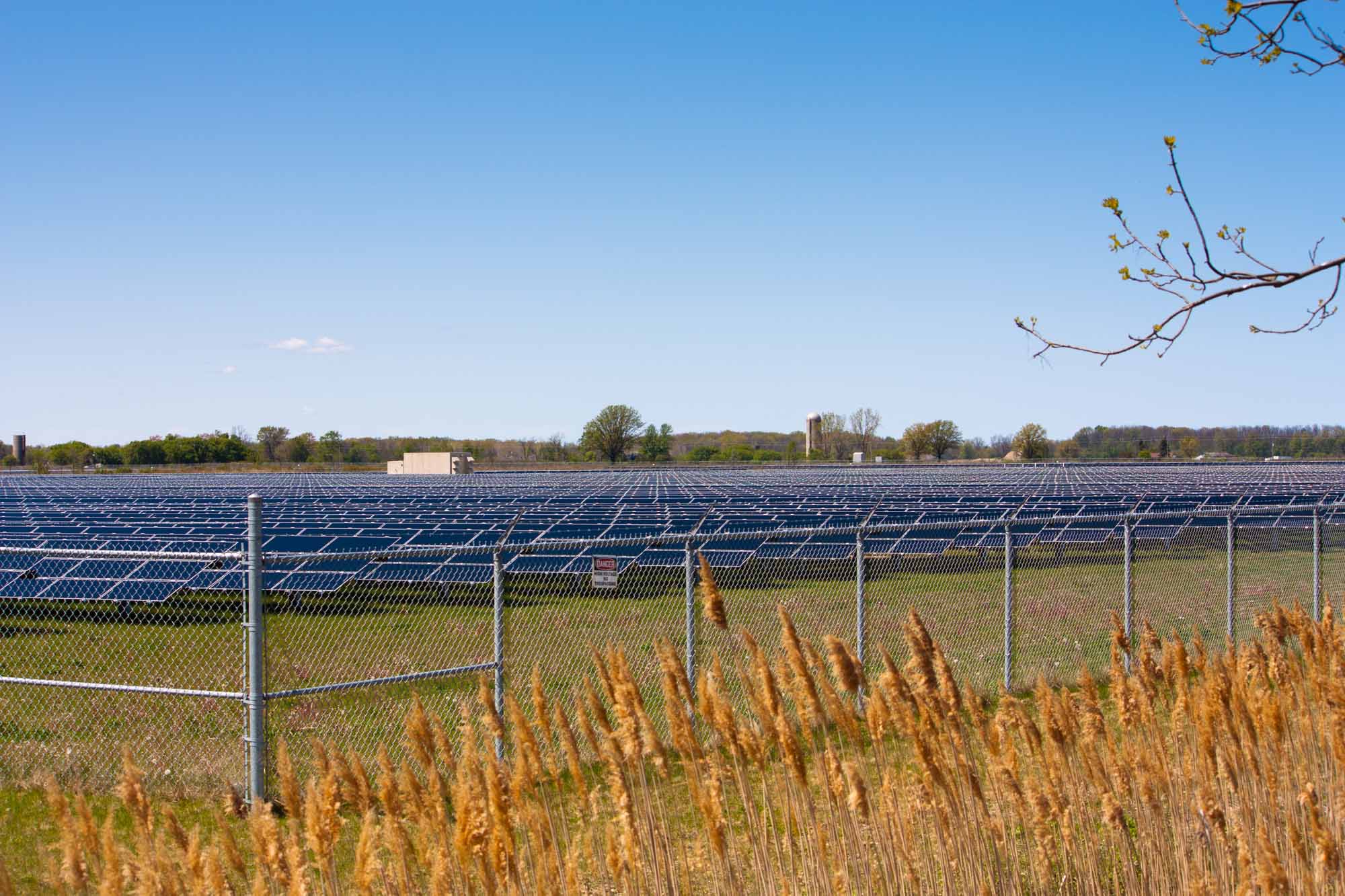The energy contained in sunlight is the source of life on Earth. Humans can harness it to generate power for our activities without producing harmful pollutants. There are many methods of converting solar energy into more readily usable forms of energy such as heat or electricity. The technologies we use to convert solar energy have a relatively small impact on the environment. However, they each have disadvantages that have kept them from being widely adopted.
In Canada, the use of solar energy to generate electricity and heat is growing quickly and is helping reduce pollution related to energy production. Despite Canada’s cold climate and high latitudes (which get less direct sunlight than mid-latitudes), solar power technologies are used in many places, from household rooftops to large power plants. The Canada Energy Regulator (formerly the National Energy Board) expects solar power to make up 3 per cent of Canada’s total electricity generation capacity by 2040.
What Is Solar Energy?
Solar energy is the energy generated by the sun and radiated through space, mostly as visible and near-infrared light. It sustains nearly all life on Earth. When sunlight strikes a surface on our planet, thermal energy, also called heat, is produced. This thermal energy drives several global phenomena, including the water cycle, wind patterns and ocean currents. Photosynthesis, the process by which plants produce their own food, occurs through the conversion of sunlight into chemical energy.
How Is Solar Energy Captured and Stored?
The natural conversion of sunlight into other forms of energy has inspired the ways humans capture and use this energy. Broadly speaking, there are two methods of using solar energy: passive and active. Passive solar methods are those that use sunlight directly (e.g., lighting and heating a room through a window). Active methods use technology to convert solar energy into a secondary form (e.g., a fluid or electricity) that has its own use.
Passive Solar
Humans have used passive solar collection for thousands of years to accomplish otherwise energy-heavy tasks with little effort. Early examples include sun-drying fruits and vegetables or using the sun’s evaporation of water to make edible salt for preserving meats.
As human society became more complex, it developed new passive solar technologies. Regulating light and heat in buildings became a main application of these technologies. One of the simplest examples is the glass window, which allows sunlight to pass through a wall in a building, providing fuel-free light and heat.
Today, a key sustainable design strategy is to position buildings so that they allow maximum daylight to enter through windows. This reduces the need for electric lighting. Designing buildings based on seasonal differences in the angle of sunlight can also save energy. In winter, interior surfaces can absorb solar energy as thermal energy and release it as heat throughout the evening. Minimizing the same factors in summer can reduce the need for air conditioning.

Salmon and trout split and hung up to dry in sun and wind. Bernard Harbour, Northwest Territories (now Nunavut), 20 July 1915.
Active Solar
Thermal
Active thermal systems use solar energy indirectly. They collect solar radiation to heat a substance such as water or air, which can then heat a space, power a turbine or fulfill other uses.
Simple solar thermal collectors are common in Canada. In these systems, pipes filled with a heat-transfer fluid, such as water, are placed on a roof. Sunlight heats up the liquid within the pipes. A pump then moves this liquid into a storage tank. People can use this heated liquid directly or as part of a process that requires heat. These collectors are popular for home water heating and space heating.
More complex versions of these systems can concentrate enough solar energy to power a small city. Concentrated solar power plants use hundreds of mirrors to reflect sunlight toward a large tank filled with a heat-transfer fluid. These large plants produce electricity by boiling water, just like traditional power plants. The only difference is that instead of burning fossil fuels, they use solar energy to produce the steam that spins a turbine. These plants are most often built in deserts because they need a lot of sun with few clouds.
One of the most effective technologies for collecting solar energy is called a transpired solar collector. Invented by Canadian John C. Hollick, it is simply a piece of metal pierced with thousands of tiny holes and attached to a building. When sunlight strikes it, the metal heats up and warms the air around it. Then the air can be used to heat the inside of the building. These systems can convert up to 80 per cent of solar energy into usable thermal energy.
Photovoltaic
Photovoltaic (PV) cells are the among most technologically advanced tools for capturing solar energy. The key component of the PV cell is a thinly sliced wafer of semiconductor, a material used to control and direct electrons. Two of these wafers are stuck together inside the PV cell. One is positively charged so that it has an extra electron that can be freed or pushed out of the semiconductor. When solar energy excites and frees these electrons, they leave a hole that electrons in the second semiconductor wafer rush to fill. The movement of electrons across the gap between the two wafers creates a small electric current. The direct current (DC) from PV cells can power any number of things, from lights in a home to machines in a factory. However, changing DC to the alternating current (AC) used in most homes and businesses requires an electrical device known as an inverter. (See also Electric Power Transmission.)
The most common semiconductor material used in photovoltaics is silicon (see Silica). Silicon PV cells are generally small, but they can be combined into panels of different sizes to meet most energy needs. Some other semiconductors can be printed onto a thin film to make PV cells of almost any size.
Did you know?
Photovoltaic technology was first designed and manufactured in the 1950s to allow satellites to harness sunlight and power themselves in space.
Advantages of Solar Energy
The key advantage of solar power systems is that they help reduce pollution from power generation. Solar energy is a free resource. It arrives at the site of generation without any work from humans. There are zero emissions from the process of generating power with solar systems. By contrast, burning fuels for energy produces pollutants such as particulate matter, sulphur dioxide (SO2), carbon dioxide (CO2) and hazardous waste. (See also Petroleum; Coal; Natural Gas.)
Disadvantages of Solar Energy
Using sunlight as a fuel source has several disadvantages compared to fossil fuels. Chief among these are low energy density and intermittency.
Energy density refers to the amount of potential energy a given amount of fuel contains. No technology can convert all the primary energy in a fuel into usable energy. Fossil fuels have very high energy density. They produce a lot of usable energy, even if the conversion is inefficient. Solar energy has relatively low energy density, which conversion reduces further. The least efficient solar conversion technologies are those that produce electricity. Those that convert it into thermal energy are more efficient.
Sunshine is not constant. It changes throughout the day due to clouds and it disappears at night. Another word for the variable nature of sunlight is intermittent. The number of hours and intensity of sunlight also changes seasonally in Canada. Since sunlight is intermittent, solar power cannot be generated as consistently and predictably as power from other fuel sources.
While solar power itself is clean, some of the materials and manufacturing processes of solar technologies pollute the environment. They may harm human and ecological health at the site of manufacture and at end-of-life (i.e., when materials break down). Manufacturing solar technologies also requires large amounts of energy. Many large solar power systems have local environmental impacts such as habitat disruption.
Solar Power in Canada
Canada has access to vast solar energy resources. Moreover, the technology is becoming cheaper and more available. The number of solar power systems is growing. Governments in Canada have made policies to encourage their installation. Promoting solar and other renewable energies is one way to reduce greenhouse gas emissions. Canada has committed to reducing emissions as part of climate change agreements.
In Canada, the Prairies have the highest potential for producing solar power. This is because they have less cloud cover than the coastal and central areas. Despite the great many solar power technologies installed in recent years, solar still makes up a small share of total power generation. In 2017, solar power plants represented just over 1 per cent of Canada’s total electrical power generation capability.
In 2021 Hydro-Québec inaugurated two solar generating stations. The Gabrielle-Bodis generating station, located in La Prairie, Quebec, and the Robert-A.-Boyd station, located in Varennes, Quebec, have a combined installed capacity of 9.5 MW. Annually the two stations will be able to generate 16WGh of solar power. By investing in this form of renewable energy Hydro-Québec is evaluating the future of photovoltaic power generation in Quebec.

 Share on Facebook
Share on Facebook Share on X
Share on X Share by Email
Share by Email Share on Google Classroom
Share on Google Classroom













